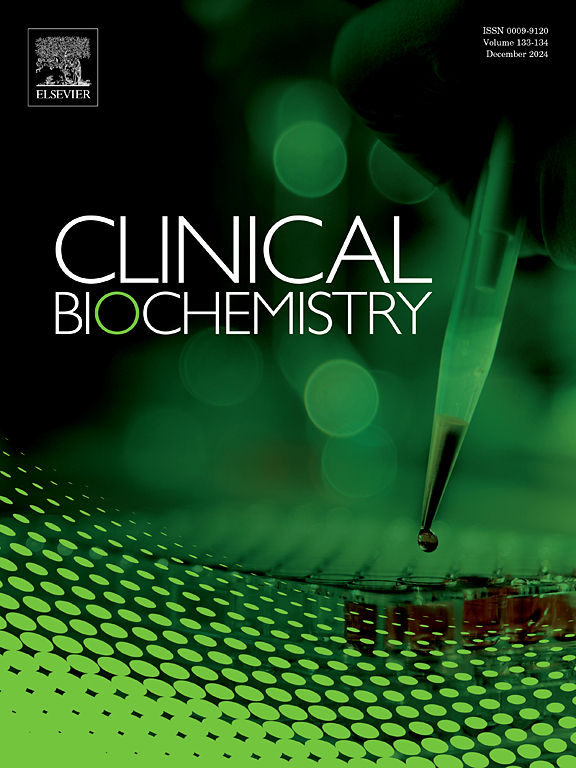Phosphatidylethanol clearance after packed red blood cell transfusion
IF 2.5
3区 医学
Q2 MEDICAL LABORATORY TECHNOLOGY
引用次数: 0
Abstract
Objectives
Phosphatidylethanol (PEth) is a long-term marker of alcohol consumption used clinically for evaluating abstinence in patients including transplant candidates. Packed red blood cell (pRBC) transfusion can introduce exogenous PEth to recipients, complicating interpretation. This study evaluated the kinetics and duration of PEth 16:0/18:1 positivity post-transfusion.
Design & methods
This study evaluated liver transplant recipients (n = 76) who received ≥ 1 pRBC during transplantation surgery. PEth 16:0/18:1 concentrations were monitored up to 2 weeks post-transfusion to determine clearance kinetics.
Results
Post-transfusion PEth was ≥ 10 ng/mL (range 10.0 – 79.7 ng/mL [0.014–0.113 µmol/L]) in 37 (48.7 %) recipients. Approximately 24 h after transfusion, pRBC-derived PEth decreased by a mean of 19 %, consistent with pRBC turnover post-transfusion. After 24–36 h, the apparent half-life of PEth was 6.6 d but was highly variable (SD 3.6 d). Correction for hemoglobin or hematocrit improved variability, with mean half-life estimated at 4.9 d (SD 1.6 d) and 4.6 d (SD 1.4 d), respectively. Time to clearance of PEth < 10 ng/mL ([<0.014 µmol/L]) ranged from < 1 d to > 19 d; 15 (40.5 %) pRBC recipients cleared PEth within 5 d post-transfusion. Using the consensus cutoff for PEth interpretation, only 10 had PEth > 20 ng/mL (>0.028 µmol/L) at 5 d and all had 14 d values < 20 ng/mL (<0.028 µmol/L).
Conclusions
These findings suggest that PEth positivity after pRBC transfusion might be more common than previously recognized, and that higher decision-making thresholds (e.g., 20 ng/mL [<0.028 µmol/L]) are appropriate. Post-transfusion kinetics are not identical to clearance of endogenously-produced PEth after alcohol consumption (half-life 5–8 d), likely due to both patient and pRBC characteristics. Transplant care teams should recognize the risk for pRBC transfusion to impact PEth concentrations in recipients, and interpret PEth cautiously for 2–3 weeks after transfusion.
填充红细胞输注后磷脂酰乙醇的清除
目的:磷脂酰乙醇(PEth)是临床用于评估包括移植候选者在内的患者戒酒情况的长期酒精消耗指标。填充红细胞(pRBC)输血可将外源性PEth引入受体,使解释复杂化。本研究评估了输血后PEth 16:0/18:1阳性的动力学和持续时间。设计,方法本研究评估了移植手术中接受≥1个pRBC的肝移植受者(n = 76)。输血后2周监测PEth浓度16:0/18:1以确定清除动力学。结果37例(48.7%)受者输血后PEth≥10 ng/mL(范围10.0 ~ 79.7 ng/mL[0.014 ~ 0.113µmol/L])。输血后约24小时,pRBC衍生的PEth平均下降19%,与输血后pRBC周转一致。24-36小时后,PEth的表观半衰期为6.6 d,但变化很大(SD为3.6 d)。血红蛋白或红细胞压积的校正改善了可变性,平均半衰期估计分别为4.9 d (SD为1.6 d)和4.6 d (SD为1.4 d)。清除PEth的时间;10 ng/mL ([<0.014µmol/L])范围为<;1 d到>;19 d;15例(40.5%)pRBC受者在输血后5天内清除了PEth。使用PEth解释的共识截止值,只有10个具有PEth >;20 ng/mL (>0.028µmol/L),均有14 d值<;20 ng/mL (<0.028µmol/L)。这些发现表明,pRBC输血后PEth阳性可能比以前认识到的更常见,并且更高的决策阈值(例如20 ng/mL [<;0.028µmol/L])是合适的。输血后的动力学与饮酒后内源性白思的清除不相同(半衰期5-8天),可能是由于患者和pRBC的特征。移植护理团队应认识到输血pRBC会影响受者体内PEth浓度的风险,并在输血后2-3周内谨慎解读PEth。
本文章由计算机程序翻译,如有差异,请以英文原文为准。
求助全文
约1分钟内获得全文
求助全文
来源期刊

Clinical biochemistry
医学-医学实验技术
CiteScore
5.10
自引率
0.00%
发文量
151
审稿时长
25 days
期刊介绍:
Clinical Biochemistry publishes articles relating to clinical chemistry, molecular biology and genetics, therapeutic drug monitoring and toxicology, laboratory immunology and laboratory medicine in general, with the focus on analytical and clinical investigation of laboratory tests in humans used for diagnosis, prognosis, treatment and therapy, and monitoring of disease.
 求助内容:
求助内容: 应助结果提醒方式:
应助结果提醒方式:


